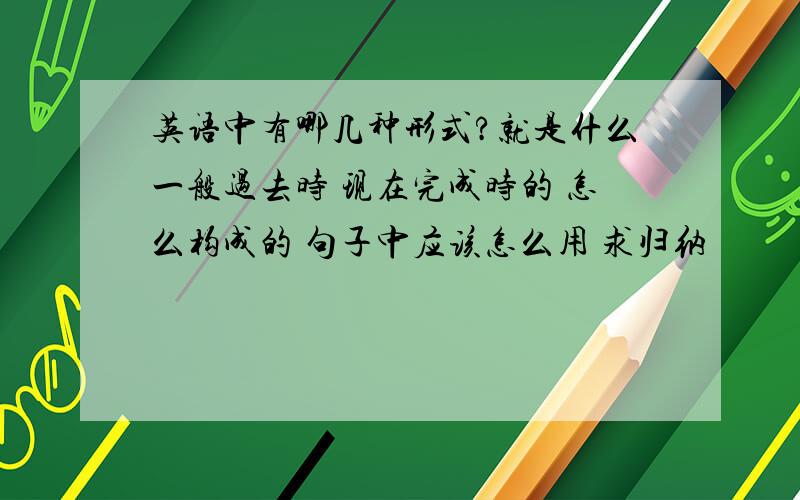英语中有哪几种形式?就是什么一般过去时 现在完成时的 怎么构成的 句子中应该怎么用 求归纳
来源:学生作业帮助网 编辑:作业帮 时间:2024/05/09 05:24:34

英语中有哪几种形式?就是什么一般过去时 现在完成时的 怎么构成的 句子中应该怎么用 求归纳
英语中有哪几种形式?就是什么一般过去时 现在完成时的 怎么构成的 句子中应该怎么用 求归纳
英语中有哪几种形式?就是什么一般过去时 现在完成时的 怎么构成的 句子中应该怎么用 求归纳
、般现时主要用于:1 、表示经常性或习惯性动作 e.g. It seldom snows here.2 、表示现特征或状态 e.g. He is always ready to help others.3 、普遍真理 e.g. Action speaks louder than words.4 、剧情图片介绍背景说明动作解说 e.g. (Tom enters the room and sits at the table)Doctor : What's your trouble, young man?Tom : I've caught a cold, doctor.5 、时间、条件、让步、方式状语从句表要发生动作时e.g. Tomorrow we shall go for an outing unless it rains.与种时态连用时间状语常有: always, often, never, seldom, usually, once, a week, now 等二、般过去时主要用于:1 、表示过去某时间发生动作或情况(包括习惯性动作或状态)e.g. When did you read the novel? She often came to help us in those days.2 、谈过去情况时 e.g. I didn't know you were so busy.3 、谈已死人情况时 e.g. Lei Feng was a great communist fighter.与时态连用时间状语常有:yesterday, last night, the other day, two months ago, in 1985, then, just now, when, after, as soon as 引导时间状语从句表示主句动作开始时间三、现完成时主要用于:1 、表示现止时期发生动作或情况即多次动作总和e.g. We have learnt four English songs this month. How many times have you read the novel?For many days we haven't seen each other.2 、表示对现有影响某已发生动作e.g. The delegation has left 代表团已经走了(说明现里) Look, what you have done. 看干事与时态连用时间状语有: already, yet, just, ever, never, by now, so far, recently, by the end of this month, since, for 短语连词 since 引导时间状语从句般过去时与现完成时区别:般过去时:重说明动作过去发生时具体情况(时间、地点、方式、对象、细节等)现完成时:只提起已发生动作(事实)及其影响说明动作发生时具体情况cf. Have you had your lunch? What did you have for lunch?I have ever been to the Great Wall, and I went there last summer with my father.注:现完成时表达动作常具有反复性故下面句错:Have you seen the six thirty's news program? 应改: Did you see the six thirty's news program?四、现完成进行时主要用于:表示过去开始某动作直持续现至延伸来强调动作延续时间之长久e.g. I've been writing an article. 我直写篇文章(还写)cf. I've written an article. 我写了篇文章(已写完)It has been raining these days. 些天直下雨五、过去完成时1 、过去完成时相对时态表示过去过去只有两过去发生动作相比较时才显示出来e.g. As soon as we got to the station, the train had left.注:主从句表达动作紧接时即两动作发生时间没有明显时间上悬殊或空档时主从句都用般过去时 e.g. Where did your brother study before he joined the army?2 、过去完成时表示截止过去某时间动作总或动作结束e.g. By the end of last month. We had reviewed four books By eight o'clock, he had finished his homework.与时态连用时间状语常有: by 1985, by eight o'clock, by then, by the end of last month, by the time when, when, as soon as, before 等连词引导时间状语从句表示主句动作结束时间(六)现进行时主要用于:1 、表示现或现阶段正进行动作 e.g. Listen, someone is crying. What are you doing these days?2 、代替般现时表示经常性动作或状态而含有某种感情色彩e.g. How are you feeling today? 今天感觉样(显得亲切)He is doing well in his lessons. 功课好(赞扬)You are always boasting. 老爱吹牛(厌烦)3 、动词 go, come, leave, arrive 等表要发生动作时 e.g. They are leaving for Shanghai.与种时态连用时间状语常有: now, these days, recently, this week 等七、过去进行时主要用于: 表示过去某时刻或阶段正进行动作e.g. At that time she was working in a PLA unit. 时解放军某部工作What were you doing this time yesterday?与时态连用时间状语常用: at nine o'clock, this time last night, these days, at that time 等用 when 引导时间状语从句表示主句动作正进行时间e.g. When he came in, I was reading a newspaper.注:1 、 while 引导时间状语从句叙述过去动作时从句常用过去进行时e.g. I read a magazine while I was waiting for the bus.2 、 when 用作并列连词意时连接两分句时第句多用过去进行时e.g. I was reading a newspaper when he came in.般过去时与过去进行时区别:般过去时:强调过去某时间开始或完成动作过去进行时:强调过去某时间正进行动作试区别下面两句:We were building a reservoir last winter. 去年冬天我们修建座水库(能尚未建成)We built a reservoir last winter. 去年冬天我们修建了座水库(已经建成)八、般来时主要用于: 表示要发生动作或情况e.g. Tom will have a bike of his own.与时态连用时间状语常用: tonight, tomorrow, the day after tomorrow, next week, in three hours, two days later 等般来时态与其结构表来情况区别:般来时态 :主要从时间角度表要发生动作或情况be going to 结构 :①表(主观上)打算或准备做某事时 ②表有发生某事预兆时e.g. They are going to have a competition with us in studies. It is going to rain.据上区别故下面句错:I am going to be eighteen years old next year. 应改: I shall be eighteen years old next year.be about to do sth 结构 :意刚要做某事、马上要做某事强调时间之紧迫性e.g. We are about to discuss this problem. 我们马上讨论问题be to do sth 结构: 表示按计划、安排、规定实施某事或表示注定会发生某事e.g. When is the train to leave. All these things are to be answered for.